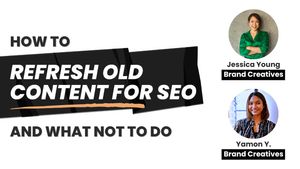Ah, ye old content refresh.
Pause content creation for a moment. We're revisiting your vast library and squeezing more juice from it.
Expect to learn:
- The power of updating old content (case study)
- Some clarity: Which content should I actually update?
- How to actually refresh content (our 8 tips, which is actually more like 20 tips squished into 8 points)
- The one thing I really wish someone told me on day 1 of my SEO career
- Systemizing the content refresh
In at the deep end 🫡
Content Refresh Case Study (0 to 5,500 Visitors)
In this week's How the F*ck podcast interview, Jess and Yamon from the brand creatives shared a case study that shows how crazy powerful content updates can be.
They updated this article for their client.
Before the update, it ranked on page three and got zero traffic. Now, this article ranks for 88 keywords in positions 1-3 and gets 5,500 organic visitors each month.
A look at Wayback Machine from before the update reveals they made four core changes:
- Contextual internal links were added
- Core keywords were added to H1 and H2s
- Content was rewritten to be more engaging
- Readability was improved (with shorter paragraphs and bullet points)
Jess notes that content updates are typically quick wins because most companies fail to actually search optimize them.
“I think with a lot of SaaS companies just keep pumping out content. There is an insane urge to have a machine. Like "every week we have to have a [new] blog post" and it just keeps going and going, and there's no looking back at what they've published so far.
Also, a lot of companies lack basic SEO knowledge, right? They can create a big, nice piece of content, useful thought leadership, but if it's not optimized for SEO is just stands on page 10.”—Jessica Hill Young, How the F*ck Podcast
Furthermore, old web pages have also been indexed the longest. They’ve accrued the most authority and backlinks and usually a spruce-up will quickly increase rankings.
Which Content Should You Refresh?
When refreshing, it makes sense to prioritize content where your work will have the most impact.
Typically, that means pushing an article from an already high position to a slightly higher one (e.g. position 3 to 7, where it will see a large jump in clicks).
Or it means updating content that once performed well, bringing it back from the dead—which is much easier to do than starting from scratch.
Here’s how two of my favorite SEOs approach this challenge:
Update Decision Tree - Advice from Jess Lam Hill Young
When Jessica’s team does a content audit, she aggregates all the website’s content into a large spreadsheet that, in turn, tells her things like the keywords, traffic, and index status of each page. (Data from ScreamFrog, Ahrefs, GSC, GA, and Supermetrics).
To choose which blog posts get an update, they use this decision tree:
- If 2 or more pages are ranking for the same keywords, we merge them into 1 page
- If a page has low traffic (less than 5), no relevance, and no conversion, then we 301 redirect it to a more relevant page, rewrite it, or delete it
- If a page ranks between positions 3 to 30, we do a light refresh (these are the biggest potential pages)
- If a page is NOT ranking, out of date, is less than 1,000 words, missing keywords or on-page elements, we mark it for a Rewrite/Refresh or add more links
The ‘Big Three’ to Refresh - Advice from John Bonini
I often refer to John Bonini’s advice on content updates.
“It’s 2022 and so many marketing teams will start this year focusing on net new content in order to hit short-term growth numbers. Don’t do that. Not right now.”—John Bonini
He recommends updating these types of posts in priority:
- ✅ The Biggest Losers: Content that’s decayed (lost organic traffic) at a high volume over the last 3,6,12 months.
- ✅ The Almost Famous: Content that’s currently ranking on page 2. An update could give it the bump it needs to drive material increases in organic traffic.
- ✅ The Nobodies: Content that’s targeting high-intent, high-volume keywords that are not ranking at all. These need to be rewritten and restructured.
“The biggest opportunity are 'The Biggest Losers'. These are pages with existing authority, a backlink profile, etc. They just need a refresh to get back on track. You can find these pages easily in Google Analytics by using the comparison functionality to track organic traffic to your content in Q4 compared to Q3 of last year, then, filtering by the biggest percent changes.”—John Bonini
To take a closer look at which traffic is decaying, use my content decay calculator here.
How to do a Content Refresh (8 Questions)
Now you’ve identified which content to refresh, let’s look at how to refresh them.
Here is an 8-question checklist for updating old content:
1. Does the article have a focus keyword?
While an SEO article can rank for 100s of keyword variations and closely related keywords, each article should have one focus keyword.
(For example, the article you’re reading right now is optimized for the keywords “content refresh” and you should be able to tell from the URL, H1, H2, and topics I cover.)
In the interview, Yamon notes her process for finding a focus keyword:
“The approach we take to choosing a focused keyword is a bit different for existing content. We plug the article to be refreshed into Ahrefs, look at the keywords it's already ranking for, and pick the one that:
- Relates most to the article/company use case
- Has a volume of 100+
- A difficulty of below 30"
This is important because each keyword has “search intent” behind it. To win in Google your content needs to fulfill that intent, which means you need to focus on just one intent.
2. Does the article have basic on-page optimization?
Yamon from The Brand Creatives shares her checklist for on-page optimization here, she includes:
🔲 Write 60%-150% of the average competitor word count
🔲 Content grade must be at least A- on ClearScope
🔲 Add images under every H2
🔲 Add alt texts and captions for every image
🔲 Write a meta description (less than 160 characters)
🔲 Add primary keyword in meta, title, first paragraph, first H2, sentence after first H2
🔲 Add at least 8 internal links
🔲 Add external links to sources and statistics (they note that they give it a chance to rank for 3-4 months before adding external links)
🔲 Final check for grammar, spelling, and flow
“Having the right H2s matters a lot in content updates. We find that H2s that match what people are asking on Google works really well for ranking.”—Jessica Hill Young, How the F*ck Podcast
3. Does the article fulfill search intent?
Search intent is the “why” behind a query in Google. What is the need or pain the user really wants to address?
In this Ahrefs article, the author notes a 677% increase in traffic by simply tweaking a landing page to match search intent.
You can often infer intent from the words used:
But this is a simplistic approach that doesn’t quite get to the heart of what users want.
Here are two other options:
- Look at what currently wins in Google. The titles of the top 1-5 results should show you what users want to see (and what they click on most).
- Use a tool like AlsoAsked to look at what questions people are asking on that topic. These questions show specifically what people want to know and can indicate what topics are important to cover in your article.
To have the best shot at ranking #1, assess your content and ask “is this article really helping the reader solve their needs?”
I’ll finish this section with a quote from Jess:
“More importantly, a good writer should be able to look at the piece of content and make sure it's useful for the search intent. Not just thinking about stuffing keywords in, but really reading it with a fresh eye. Does it have a good intro? Is the headline intriguing? Is this useful information that people wanna read about and does it relate to your client's product?
That is also why I think we've been successful because if you just follow the steps, I mean, it would help, but you need to have the substance because even if you hack the algorithm, if it's just a bunch of keywords and you're just adding sessions in, you're probably not gonna stay long on page one.”—Jessica Hill Young, How the F*ck Podcast
4. Does the article match (and beat) competitors?
Jess and her team use a tool like Clearscope, Writerzen, or Frase to get a competitor analysis.
It should tell you:
- Is your average word count about the same?
- Are you using relevant keywords throughout the content?
- Do you have the right headings?
It’s important to not just match or replicate competitor content, but to be much better.
Google filed a patent in 2020 around “Information Gain” which aims to reward web pages with different and unique content.
5. Does this content have outdated information?
Read through your article with your target audience’s eyes.
Does it still make sense in 2023? Are the stats and advice still relevant?
If not, remove them or find the latest data.
6. Does this article cover the topic completely?
If your content is thin, say 500 words, then it might struggle to really serve the reader's needs.
Your goal is to have an article that completely satisfies a user’s lust for knowledge.
That means:
- Cover a topic comprehensively
- Don’t create more questions than you answer
- Don’t forget to cover FAQs and “what not to dos”
“It's easy to write a 500-word article, but to plan a 2,000-word article and for a 2,000-word article to be good, it takes substantial effort. So I think that's why we see so much of these fluff pieces online.”—Jessica Hill Young, How the F*ck Podcast
Great content is actionable content. You finish reading ready to solve your problem.
Sometimes an article might be so thin that starting from scratch with a proper SEO outline might be the answer. Especially if you’ve changed the focus to a slightly different core keyword.
7. Does this article have a good user experience?
In my recent carousel on LinkedIn, I stressed the importance of good UX in SEO.
Things like:
- Use short paragraphs and concise language
- Have short and descriptive introductions
- Use a table of contents
- Use custom imagery
All these things add up to better digestibility which increases dwell time and improves content consumption.
8. Does this article have unique insight, expertise, and experience?
Many companies deploy the “minimum viable content” approach to scaling content production. In short, that means publishing content before it’s 10/10 perfect.
For example, in my case study with Ash from Living Cozy we discuss the concept of “layering”.
In layer one, a simple product review is written and published.
In layer two, he asks interior designers for their advice on the product, incorporates, and republishes.
And so on, until the final later where he ships the products to the writer for a first-hand ‘experiential’ review.
Jess and I discuss a similar approach in the podcast.
Since the extra E was added to E-E-A-T, her content update process also includes adding insight and expertise from sources like customer support calls and customer interviews.
For those wanting to bring a quality feel to their content, I recommend updating through this lens, too.
What NOT to Do With a Content Refresh
I’ve been down this rabbit hole a few times now, and something I wish someone told me on day one is this.
If an article is ranking well and getting traffic…don’t rewrite the whole article.
An article sitting in position 3-6 that hasn't been touched for a while will benefit from a tweak here and there.
But fundamentally changing the page may not always be a good thing.
Think about it, Google has chosen to rank your article there for a reason, completely tearing it down and rewriting it is unnecessary and may even tank your rank.
Systemizing the Content Refresh
Content updates are always my first point of call when working with a new client.
Why? Because they’re quick wins. As we’ve seen from the case studies mentioned today, small tweaks and optimizations can have a large impact.
If you're currently building a content operation and scaling content production, don't forget to build content updates into your workflows.
It's as simple as setting a reminder to revisit content every quarter to look at what happened.
In my case study with the monday.com SEO team (part 2 here), they told me they set alerts for certain SEO metrics (for example, if a new blog post starts getting traffic for the first time).
A quarterly reminder to update old content is an automated workflow you could set up, too.
More content you might like:


